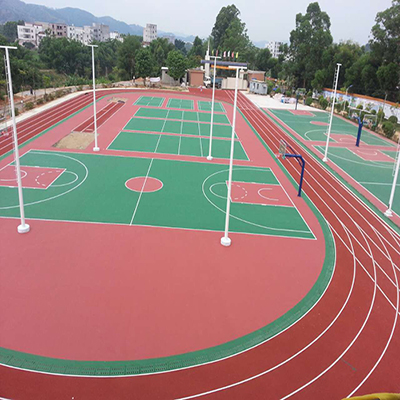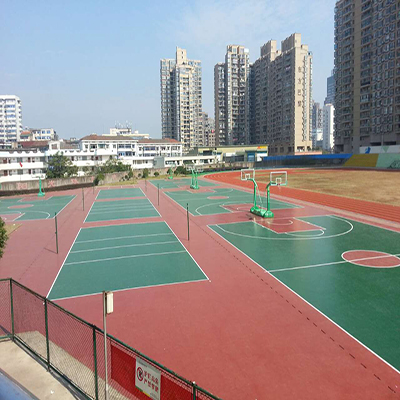Silicon PU material construction
(Elastic layer → elastic layer → surface layer → scribing)

1. Elastic layer:
Before the construction of the elastic layer, carefully check and confirm that the foundation treatment can be carried out. The elastic layer (TB-002) is a one-component water-absorbing curing material, which can be directly applied to the base surface with a toothed scraper. The thickness of each coating cannot be If the thickness exceeds 2.5mm, the time interval between each coating and scraping is the first one to dry and solid (generally about 10 hours, depending on the weather conditions on site) until the scraping reaches the required thickness. When the temperature is low, when the paint consistency increases, an appropriate amount of thinner (xylene, ethyl acetate, 200# solvent oil) can be added to adjust the construction consistency. If the temperature is lower than 15℃ and the relative humidity is low (<60%), it needs to be added 3~5% water is evenly stirred and then applied and scraped to accelerate the curing of the material and reduce the interval time. The specific amount of water added depends on the weather on site. Before using the thinner, a small test must be done (according to TB-002: thinner=10:3, stir evenly to make a small sample of 1.5~2mm thick), and confirm that the diluted material is cured without any problem before it can be used. Construction should be avoided under high temperature and scorching sun. After construction, it should be kept free from strong sunlight for 2 to 3 hours, otherwise the surface will bubbling due to the surface forming too fast. After the elastic layer is dry, test the surface flatness by the water accumulation method, and repair the water area with TB-002. If there are granular debris or accumulations on the surface, you need to use a mill or other tools to smooth the reinforcement layer.

2. Strengthening layer:
The reinforcement layer (TB-003) is a one-component water-absorbing material, which is directly applied on the trimmed elastic layer with a rubber squeegee in 1 or 2 passes. The surface must be smooth and flat after squeegee, and before the time interval of each squeegee. One dry solid shall prevail (generally about 10 hours, depending on the weather conditions on site) until the coating reaches the required thickness. If the temperature is low (<12℃) and the relative humidity is low (<60%), you need to add 2~5% water, stir evenly, and then scrape to accelerate the curing of the material and reduce the interval time. The specific amount of water added depends on the weather on site. . If the temperature is low and the paint consistency increases, an appropriate amount of thinner can be added to adjust the construction consistency. Construction should be avoided under high temperature and scorching sun. After construction, it should be kept free from strong sunlight for 2 to 3 hours, otherwise the surface will bubbling due to the surface forming too fast. In the construction process, if there are impurities mixed in or scratched with unevenness, the surface construction can be carried out after trimming and smoothing.

3. Surface layer:
The surface layer (TB-205) is a two-component water-based material, and the two components must be fully stirred according to the specified ratio (group A: group B=100:7 (weight ratio)), (inaccurate ratio will affect the surface layer The curing effect of the surface layer directly affects the performance of the surface layer) Add water to dilute the construction consistency, generally add 50-80% (TB-205 weight calculation, depending on the actual situation on the site), and spray on the reinforced layer in multiple passes with a special spray gun. Need to add special sand for spraying with rough surface. The lowest temperature is lower than 5℃ and it is not suitable for construction. After construction, keep it for 10 hours without water soaking. Reference practices for various court surfaces:
A. Basketball court: spray in three passes, add 30% (calculated by weight of TB-205) special sand for the first and second passes, the amount of each layer of TB-205 is about 0.12kg, and the third layer does not add sand (the amount is about 0.06 kg), when adding sand, first mix component A and special sand evenly, then add component B and stir evenly, and then add water to dilute; the three-second forbidden zone should be filled with three sands, one without sand (a total of four) ).
B. Tennis court: spraying in three passes, 50% sand is added to the first pass, 20% sand is added to the second pass, and no sand is added to the third pass.
C. Badminton and volleyball courts: Three sprays without sand.
4. Scribe
Measure and locate according to the standard size, mark the position of the boundary line, paste it on the court along the two sides of the boundary line with masking paper, paint it between the masking paper with special marking paint (TB-207), and tear off the masking paper after the surface is dry . TB-207 is a two-component material. The two components A and B must be fully mixed according to the specified ratio (A:B=100:7), and painted in two passes. If the surface of the court is rough, the first layer can be painted with 20% special sand to prevent seepage.
5. Matters needing attention:
5.1 The materials must be accurately weighed and mixed evenly when mixing.
5.2 When using any auxiliary material, it must be tested and confirmed before construction before it can be used.
5.3 The surface of each process must be kept clean before construction during the whole construction process.
5.4 The indoor venue must ensure good ventilation.
5.5 After the site is laid, it must be kept for more than 5 days before it can be put into use.